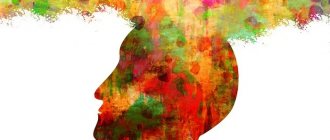What is self-awareness
Self-awareness
- this is a person’s understanding of the essence of his own personality, awareness of his place in society and the whole picture of the world. This is the vision and analysis of personal emotions, feelings and motives of behavior.
The peculiarity of self-awareness is that a person figuratively bifurcates:
- on the one hand, he is an object of knowledge for himself;
- on the other hand, consciousness acts as a subject for studying an object.
With the help of self-awareness, we see our emotions, feelings and needs, understand the motivation for our actions and what role we play in society. We recognize ourselves as a separate unit, a personality, but at the same time, embedded in the surrounding objective world.
A person can say about himself: “I am Evgeny Ivanov, I am 47 years old, I am a mechanic. I have parents, a wife and two children. My needs for a roof over my head and food are satisfied. I have friends with whom I spend time fishing and satisfy my need for communication. But I also want to have a car and play tennis, and now I’m working to achieve these goals.”
Of course, the description presented is very primitive, but it reflects the essence of the self-awareness of a person who understands his characteristic features and characteristics that distinguish him from other people.
Collective identity
Let's move on to the analysis of the collective
, or
ethnic, self-awareness
. Their self-awareness, which is expressed through cultural traditions: music, dances, customs, rituals, is closely connected with the mass consciousness of a people or nation. The self-awareness of a people or nation is a reflection of his or her characteristics, including culture and language. It is capable of stimulating the consolidation of people, the orientation of specific masses towards achieving success, and realizing the interests of the country.
So, in the period I960-1970s. Soviet media promoted the ideas of equality, mutual assistance and friendship of peoples. Manifestations of interethnic tensions were hushed up or, in those rare cases when they were made public, they were publicly condemned.
End >>>
Personal self-awareness in psychology
The concept of self-awareness is so complex and multifaceted that in psychology there is still no single concept of its understanding. Synonyms for the word are: “I am a self,” “I am a concept,” “self-identity.”
The basics of the concept were formulated by S.L. Rubinstein, who pointed out the possibility of self-awareness to understand oneself, the personal environment and the existing structure of relationships with people.
According to S.V. Vygotsky, self-consciousness is formed in a person by the end of adolescence. He connects this process with the ability to reflect (think, ponder), which is formed by the age of seven.
According to the theory of V.S. Merlin's understanding of himself consists of the following components:
- Distinctive features from other subjects and objects.
- Understanding your own emotions, having self-esteem.
- Awareness of oneself as a subject of activity.
Psychologists have identified the following criteria for self-awareness:
- Isolation of the individual from the environment (material and social).
- Understanding the ability to control oneself – actions and thoughts.
- Trying on the visible qualities of other people.
- The ability to see your needs and the deep motives of your actions.
- Awareness of one’s own character traits and personality traits, both existing and desired.
In addition, within the framework of self-awareness in psychology, such a factor as attitude towards other people is highlighted; it can also be different.
The egocentric layer assumes that the individual forms an attitude towards others in accordance with their attitude towards themselves. That is, if they love me, then I love, if they respect me, then I will respect.
The group-centric stage of relationships is based on the principle: “If a person belongs to a certain group, then he is correct.” It is assumed that the person himself belongs to this same group.
A prosocial approach ensures understanding of the value of any person and acceptance of him with all his shortcomings.
At the highest, estoholic level, other people are considered as part of the spiritual world, humanity and patience are positioned in relation to any individual.
↑ Self-knowledge
A person has an inherent desire to understand not only the world around him, but also himself. Philosophers of the world adhere to the wisdom carved several centuries ago on a column of the Delphic Temple: “Know yourself and you will know the world.” Self-knowledge
is a form of independent study by a person of his own mental and physical characteristics.
Self-knowledge can be either purposeful or not purposeful. The most important mechanism of self-knowledge is reflection
- reflection in the mind of the consequences of one’s own actions, thinking about one’s behavior. In self-knowledge, subject and object coincide - a person knows himself.
- Types of self-knowledge:
Indirect (performed by analyzing one’s own activities. - Direct (comes in the form of introspection.
On the basis of self-knowledge, a person’s worldview is formed and relationships with the outside world are formed. To describe such processes, psychologists use the concept “I-concept”.
Structure and functions of self-awareness
Regarding the structure of the concept in psychology, there is also no single approach; several alternatives are considered.
Thus, in the works of V.S. Mukhina’s self-awareness includes: identification of a person with his own property and physical body, gender, self-esteem and claims to evaluation by society.
V.S. Merlin sees the structure of the concept somewhat differently and includes in it:
- Understanding personal mental characteristics.
- Awareness of the “I” as an active subject.
- Recognition of personal identity.
- Assessing one’s own mental qualities from the point of view of moral and ethical rules.
V.V. Stolin defines the following parts of self-understanding: self-esteem, the created image of oneself (body, emotions, feelings), the conflicting essence of one’s “I”.
Summarizing the existing concepts, the structure of self-knowledge can be represented as follows:
- the cognitive part
is a person’s awareness of all aspects of his own personality; - self-esteem
– a person’s attitude to his characteristics, both physical and spiritual, emotional;
- self-regulation
– a person’s ability, based on knowledge about himself, to control, regulate and correct his behavior and actions.
In addition to different periods of life, the structure of self-understanding also includes:
- "I" today
. This is an idea of one’s personality at the current moment in time, an awareness of one’s position in reality. We evaluate existing social roles: what kind of worker, husband, father, etc. am I. If the ideal image and the real one do not coincide, experiences may arise. - "I" is desired
. These are a person’s ideas about the ideal image to which he strives. This component includes: needs, dreams and desires. It is this “I” that is the main motivator for productive activity. - “ I” is previous, including an assessment of oneself in the past
. If a person has had unpleasant or painful experiences early in life, this may hinder the fulfillment of needs in the future.
All of the listed components of self-awareness are interconnected and influence each other.
Functions
The most important function of self-awareness is self-regulation
. Since we have fully identified ourselves, realized resources (positive and negative characteristics, potential, opportunities), understand needs and desires, he can act towards creating his ideal image.
When a person is mistaken about his own needs or inadequately assesses available opportunities, he will not receive satisfaction from his activities. Either he will rush in the wrong direction, or he will not have enough strength and potential to fulfill his desire. In both cases, disappointments and the occurrence of frustrations (strong experiences due to unfulfilled hopes and expectations) are inevitable.
Self-regulation will save a person from pointlessly wasting energy and time on unnecessary goals.
The next function is self-understanding
- This is the formation of individuality. Personality is always unique, each of us is unique. Only we ourselves know what feelings we experience, how we react to difficulties and obstacles, our pain is only our pain.
We have the right to our own perception of life, personal opinion and want to be responsible for our actions. Individuality and uniqueness must be defended throughout life.
Among the main functions are the definition of personal boundaries, self-defense
. We learn to structure our behavior in such a way that we experience less toxic influence from others. Extraordinary individuals are often ostracized (persecuted) in society. Unusual abilities and appearance, one’s own view of things, different from the generally accepted one, often make a person a “black sheep” that his brothers try to peck. A conscious sense of peace and self-confidence allows you to build a strong line of defense.
For example, if a person loves his body, he will not pursue imposed standards of beauty, if he considers it immoral to do mean things, he will not make a career by “setting up” his colleagues, even if this is accepted in the team, etc.
There is such a technique in psychology. If you are confident that you are right and live according to the principles you have developed, then in the event of attacks, imagine yourself as a rubber ball that no one can pinch. It is better to lose a toxic environment than to lose yourself.
Self-Esteem Functions
The description and content of the functions of personality self-esteem, as a basic concept in psychology, are given in the table.
| Functions | Description |
| Stimulating | Motivates a person to take actions that can increase self-esteem. |
| Post forecast | Blocks actions that may affect self-esteem. |
| Regulatory | Ensures that the individual accepts tasks and makes decisions. |
| Emotional | Allows a person to satisfy needs and enjoy life. |
| Protective | Forms personality stability. |
| Controlling | Provides self-control during a person’s performance of tasks and actions. |
| Developmental | Motivates for self-development and improvement. |
Forms and levels of human self-awareness
Self-awareness manifests itself in four forms, let's look at each of them.
Self-knowledge
This concept means identifying oneself among other people and the world around us, recognizing personal qualities, the physical body, and potential.
Self-awareness comes through:
- Self-observation of the results of one’s activities, the results of communication with the environment and analysis of the compliance of the results with accepted standards.
- Understanding the assessments of other people about their personality and actions, their attitudes.
- Analysis of your feelings, emotions and needs, and their transformations.
The result of self-knowledge is the formation of a system of ideas about oneself.
Self-control
A person has the opportunity, after analyzing his essence and behavior, to correct them. Any actions and psychological states can be changed if, in the opinion of the person himself, they contradict his attitudes, do not give the desired results, or come into conflict with the outside world.
Self-esteem
Self-esteem expresses the degree to which a person accepts his qualities, characteristics and characteristics. The perception itself reveals the level of love and respect for oneself.
Adequate self-esteem characterizes a self-confident person, capable of making decisions and purposeful actions. When low, we see a person dependent on the opinions of others, with a pronounced sense of guilt and a lot of complexes. An overestimation of personal qualities reveals a person who is self-confident, arrogant, and does not accept any criticism.
To achieve life goals, self-esteem should be developed to a normal level; in psychology there are many exercises to increase the degree of self-love.
Self-acceptance
This form of self-awareness involves:
- Accepting yourself as a unique individual, without unjustified criticism and self-deprecation.
- Self-respect.
Self-esteem comes from achieving goals and satisfying aspirations. A person sets records in sports, quits smoking, finishes writing a novel - his self-esteem increases, which has a good effect on self-esteem.
In addition to forms, psychology considers 4 levels of self-perception:
- Sensual
. This is the lowest level at which one’s psychological characteristics, experiences, and physiological processes are understood. This is the stage of self-identification. - Figurative and personal
. Gives recognition of oneself as a subject of active activity. Self-actualization occurs, maintaining the identity of “I”. - Analytical (otherwise reflexive)
. A person analyzes and clarifies his thoughts and actions, observes the manifestation of emotions in critical states, analyzes committed mistakes and failures, and draws conclusions. - Active
. Based on the results and experience of the first three stages, self-regulation, motivation, correction of behavioral structures and self-control occur. This is a stage of personal change based on self-knowledge.
Going through all four levels of self-awareness indicates the maturity of the individual; getting stuck on one of them requires further development.
Self-esteem
However, people evaluate not only each other, but also themselves.
Self-esteem is a person’s assessment of his strengths and weaknesses, actions and actions, determining for himself his significance in society.
Self-esteem can be overestimated, underestimated or realistic (adequate).
Let's look at all these options with examples.
- Heightened self-esteem. With inflated self-esteem, a person thinks about himself, his qualities and traits, better than they really are. For example, instead of talking to the teacher and correcting mistakes in homework, a student with high self-esteem will say: “I myself know that everything is correct.”
- Low self-esteem. In the case of low self-esteem, the situation looks exactly the opposite. Such a person does not accept praise because he believes that it is always undeserved, that he is not worthy of everything he has, and so on.
As we understand, both options described above are two extremes: both options cause both the person himself and his loved ones a lot of discomfort and even troubles in life.
Therefore, you need to strive to have a realistic self-esteem.
- Realistic (adequate) self-esteem presupposes that a person knows his own strengths and weaknesses. At the same time, he knows how to accept objective criticism, works on his mistakes and rejoices in his achievements.
Let's consider other concepts that are related to self-esteem.
Abilities are individual characteristics of a person, which are manifested in the ability to do something, in a propensity for certain activities or professions. For example, artistic abilities, musical abilities.
Self-esteem means that a person positively evaluates his worthy actions. For example, an athlete respects himself for the results achieved in competitions and his willpower. And this is a normal process.
Self-deprecation assumes that a person criticizes his actions and scolds himself for mistakes. For example, a student received a bad grade and says to himself: “How stupid I am, I don’t know anything and I can’t do anything.” But self-deprecation is quite pointless because it does not produce any results. We have come to the concept of self-education .
Self-education is a person’s activity for self-improvement (“improvement”).
For example, the student from the example above, instead of his reasoning, went to study a lesson in order to correct a bad grade.
Or here's another example. The man was constantly quarreling with everyone. This happened to him so often that in the end he was left completely alone, without friends. Then he had to change. He reviewed his past mistakes and decided to behave differently from now on. At first he did poorly, but every time he got better and better. So gradually, over time, he managed to establish relationships with old friends and even find new ones. This is an example of self-education.
How self-awareness is formed
The process of developing self-awareness is accurately described in the works of V.S. Mukhina in correlation with the development of the child’s psyche.
At the first stage, a person’s idea of his name is formed. First, he hears it from the lips of his parents and begins to identify himself accordingly. Thanks to the name, the child realizes himself as a person, an individual. Then the surname and patronymic are added, and the specification intensifies.
In the early school period, the name may change, other interpretations and nicknames of comrades appear. In youth, many come up with other names for themselves, associating their personality with them. During this period, there are cases of changing your passport data.
The next need for self-awareness is ideas about the body, formed first through the attitude of the close environment (parents, grandparents), and then using the traditions and cultural orientations existing in the family.
The need for recognition also occurs in early childhood. The baby learns what is good and bad, what is allowed and what is not allowed. Encouraging good deeds and good behavior leads to the desire to perform approved actions.
If demands for recognition are not satisfied by adults, the child develops negative qualities - lies, aggression, lack of self-confidence, and complexes appear.
During puberty, a teenager develops a gender identity. Of course, whether a child is a boy or a girl is determined by the age of three; a little later, stereotypes of male or female behavior appear.
In the process of self-understanding, a person develops an idea of social space, i.e. conditions in which growth and development occurs:
- style and lifestyle;
- cultural and ethical values;
- moral standards;
- attitude towards religion, etc.
In adolescence, a person strives to master the widest possible social space (from a group of comrades in the yard to the sphere of politics). During this same period, reflection on the inner world deepens in order to understand one’s needs and place in society.
The main signs of the development of self-awareness are: the presence of a holistic idea of oneself, self-respect, self-acceptance, awareness of love, discovery of the inner world.
What influences the formation of self-esteem
Self-esteem is developed in a person from early childhood.
- It matters how parents show their love for their child . If love is unconditional and does not depend on good behavior, such a child will grow up with normal or high self-esteem. When he understands that he will be loved only for something (put away toys, got an excellent mark, took out the trash), then in adulthood the person will believe that he cannot be loved just like that, and a good attitude must be earned.
- The attitude of parents towards the successes and failures of the child plays a big role . Parents’ value judgments such as “You can handle this”, “Such a smart kid will definitely do it” have a positive role in the formation of self-esteem.
Accordingly, statements in the spirit of: “They don’t ask you”, “You understand a lot”, “Well, as always, you are armless” for many years lay in a person the attitude that he is “bad”, good for nothing, stupid, incompetent, etc.
Self-esteem can decline already in adulthood. For example, a person tries to build a career, works a lot, improves his qualifications, but career growth does not occur. The individual begins to doubt his abilities. If self-esteem was initially normal, the reason for the failure will be found. Low self-esteem can drop even lower.
Women are often deliberately devalued by men with whom they are in intimate relationships. A complex partner deliberately humiliates his wife or girlfriend in order to be able to impose his will on her. The woman begins to be perplexed and analyze what is wrong with her. If her parents instill self-respect and love, then the girl will break up with a toxic partner; if not, she will suffer and prove her need to an unsuitable man.
Developing Self Awareness
Self-awareness appears in a child in early infancy, and by adolescence it is fully formed. However, this does not mean that you do not need to engage in self-perception throughout your life.
Changes occur in the objective world and subjective characteristics. These changes require observation and self-knowledge.
The first step is to analyze the current external and internal situations and re-recognize yourself and your attitude to changes. For example, with age, the body begins to age and our attitude towards it, formed in early periods, will also change. On the one hand, it is required to take greater care of physical health, on the other hand, to be able to accept age-related changes without unnecessary worries, with dignity.
It is also important to bring self-esteem to an adequate (normal) state. Throughout life, the level of love and self-respect may change due to external reasons or the attitude of loved ones. You cannot allow circumstances to sow doubts about your self-confidence.
And lastly, it is necessary to promptly adjust needs and actions according to life changes. It is impossible to stop at knowing about yourself; taking the same actions that do not lead to success is not constructive. Therefore, the process of self-awareness is permanent and ends only after the physical death of a person.











